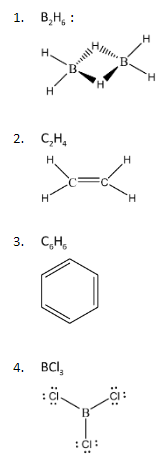
The non-planar molecule among the following is:
A. \[{B_2}{H_6}\]
B. \[{C_2}{H_4}\]
C. \[{C_6}{H_6}\]
D. \[BC{l_3}\]
Answer
137.4k+ views
Hint: In order to solve this problem, we must firstly understand the Lewis structures of the compounds to identify the types of bonds and number of lone pairs present in each compound. After that, we can make the geometrical structures of the compounds, and then compare these structures.
Complete Step-by-Step answer:
To proceed with this problem, let us first draw the Lewis Structures of the given compounds:

We can observe that some of these compounds are forming double bonds within the structure while some of them have lone pairs of electrons. The property of double bonds or pi – bonds that we must know is that they exist in the form of the shape of p – orbitals. P – orbitals have the shape of a two- lobe structure that expands over a given axis. Hence, these bonds have three dimensional geometries. Also, when it comes to lone pairs, these electrons always exist outside the lattice of the bond formation. Hence, existence of a lone pair, makes the over geometry of a relatively flat molecule into a 3 – dimensional structure.
From the Lewis structures represented above, the only compound with either a pi bond or any lone pairs of electrons is \[{B_2}{H_6}\].
Hence, the non – planar molecule among the given compounds is \[{B_2}{H_6}\]
Hence, Option A is the correct option.
Note: The bridging hydrogen atoms provide one electron each. The\[\;{B_2}{H_2}\] ring is held together by four electrons which form two 3-center 2-electron bonds. This type of bond is sometimes called a 'banana bond'.
Complete Step-by-Step answer:
To proceed with this problem, let us first draw the Lewis Structures of the given compounds:

We can observe that some of these compounds are forming double bonds within the structure while some of them have lone pairs of electrons. The property of double bonds or pi – bonds that we must know is that they exist in the form of the shape of p – orbitals. P – orbitals have the shape of a two- lobe structure that expands over a given axis. Hence, these bonds have three dimensional geometries. Also, when it comes to lone pairs, these electrons always exist outside the lattice of the bond formation. Hence, existence of a lone pair, makes the over geometry of a relatively flat molecule into a 3 – dimensional structure.
From the Lewis structures represented above, the only compound with either a pi bond or any lone pairs of electrons is \[{B_2}{H_6}\].
Hence, the non – planar molecule among the given compounds is \[{B_2}{H_6}\]
Hence, Option A is the correct option.
Note: The bridging hydrogen atoms provide one electron each. The\[\;{B_2}{H_2}\] ring is held together by four electrons which form two 3-center 2-electron bonds. This type of bond is sometimes called a 'banana bond'.
Recently Updated Pages
COM of Semicircular Ring Important Concepts and Tips for JEE

Geostationary Satellites and Geosynchronous Satellites for JEE

Current Loop as Magnetic Dipole Important Concepts for JEE

Electromagnetic Waves Chapter for JEE Main Physics

Structure of Atom: Key Models, Subatomic Particles, and Quantum Numbers

JEE Main 2023 January 25 Shift 1 Question Paper with Answer Key

Trending doubts
Electromagnetic radiation with maximum wavelength is class 11 chemistry JEE_Main

The correct order of electron affinity is A F Cl Br class 11 chemistry JEE_Main

Learn About Angle Of Deviation In Prism: JEE Main Physics 2025

Types of Solutions

Physics Average Value and RMS Value JEE Main 2025

Collision - Important Concepts and Tips for JEE

Other Pages
NCERT Solutions for Class 11 Chemistry Chapter 9 Hydrocarbons

NCERT Solutions for Class 11 Chemistry Chapter 7 Redox Reaction

NCERT Solutions for Class 11 Chemistry Chapter 8 Organic Chemistry

Elastic Collisions in One Dimension - JEE Important Topic

Free Radical Substitution Mechanism of Alkanes for JEE Main 2025

What is the significance of the Heisenberg uncertainty class 11 chemistry JEE_Main




